A Christmas summer lunch without shrimps or prawns on the barbie; is that even an Australian Christmas? Even if you steer clear of seafood, there is no doubt that many Aussies still love their fish. In fact, as a nation we consume almost 50,000 prawns every year.
The high demand for seafood sees over 65% of prawns imported into Australia, some of which is tainted by the use of slave labour. Yes, modern day slavery is still a grim reality for 45 million people around the world including people who are forced to work in the fishing trade (Global Slavery Index, 2016).
In 2015 a series of reports from Greenpeace and the New York Times shone the light on the human trafficking and modern day slavery within the seafood industry especially in the fishing and distribution of prawns and shrimp.
Thailand is the third largest importer of prawns into Australia and has a history of forced labour in the fishing trade.
Last year, an investigation by the Associated Press found a number of migrants working in poor conditions at prawn peeling sheds linked to the Thai Union supplier of big name supermarkets Coles, Aldi and Woolworths. This prompted the supermarkets to launch investigations, tracking distribution processes to ensure that their products are slavery free.
The annual human trafficking report from the US department of State stated that the Thai government still do not fully meet the minimum standards to eliminate human trafficking despite making “significant” efforts to do so . This is mainly due to the corruption within the system continues to undermine these anti-trafficking actions.
How do people end up in the seafood slave trade?
Often workers from Cambodia, Laos, Myanmar and Burma immigrate to Thailand in search of a better life. Human traffickers take advantage of this and promise them safe passage to a new country via “ghost ships” (unregistered and untraceable fishing ships).
Sometimes human traffickers pose as recruitment officers and ask for upfront fees while promising jobs with a high wages, so workers would be able to earn enough money to send back home to their families.
However, once they reach the new country they are then told they have incurred debt and have to pay off more travel expenses by working on the fishing ship. The workers often do not speak the same language as the captain. They are stranded on ship miles from the nearest port and in some cases not knowing how to swim. This financial bondage sees workers labouring for 18-20 hours a day, in unforgiving conditions with the threat of torture and being thrown overboard.
The New York Times called them, “Sea Slaves” as reports were made known of workers being sold and resold between fishing ships.
It’s not just at sea where these human rights violations take place but in the factories where the prawns and shrimp are de-shelled/peeled before being sent to overseas supermarkets including Australia. There are hundreds of peeling sheds in Thailand that also have child workers who are forced to work under threat of physical violence. The high-demand from consumers for the convenience of peeled prawns drives the labour-intensive process in these peeling sheds were workers are under a constant watch from shed owners.
What can you do?
This doesn’t mean you can’t enjoy prawns anymore, it just means being more conscious of where they are coming from. Prawns can be farmed ethically and consumers and retailers can choose to buy ethically sourced prawns. Most supermarkets have labelling that tells you where the prawns were caught and if they don’t, ask.
Stop the Traffik has petition for legislation to be introduced asking businesses to publicly disclose the steps they are taking to ensure their products are human trafficking and slavery free. As well as this, the organisation is using the 12 days of Christmas advent calendar to provide facts and keep you informed about slavery in the seafood industry.
#traceability & #transparency difficult given #complexities of the #seafood #supplychain, but @Frequentz revolutionising approaches with #IT pic.twitter.com/NJ34Isa6Il
— STOP THE TRAFFIK Aus (@StopTheTraffikA) December 15, 2016
#Collaborative response: #SeafoodTaskForce working to combat #humantrafficking in #Thailand's seafood industry. https://t.co/cO0S5pMaFA pic.twitter.com/9PUSdeSzYG
— STOP THE TRAFFIK Aus (@StopTheTraffikA) December 14, 2016
Recently, the South Australian Spencer Gulf Prawns earned a green ‘Better Choice’ rating. This rating acknowledged the fishing methods collaboration with scientists and stakeholders to ensure sustainable seafood.
Fisheries and Sustainable Seafood Campaigner, Josh Coates, said choosing sustainable seafood highlights the importance of caring for our oceans and the community.
“Australia’s Sustainable Seafood Guide is Australia’s only comprehensive guide to fisheries sustainability for Australians who love their seafood as well as their oceans.
“Our goal is to help Australian consumers make informed choices and in turn influence industry and Government to improve practices,” he said.
So this Christmas lunch choose sustainable seafood options and be confident knowing that the prawns or shrimp you put on your plate is in fact #TraffikFreeFish.
Resources
Melissa Stewart




